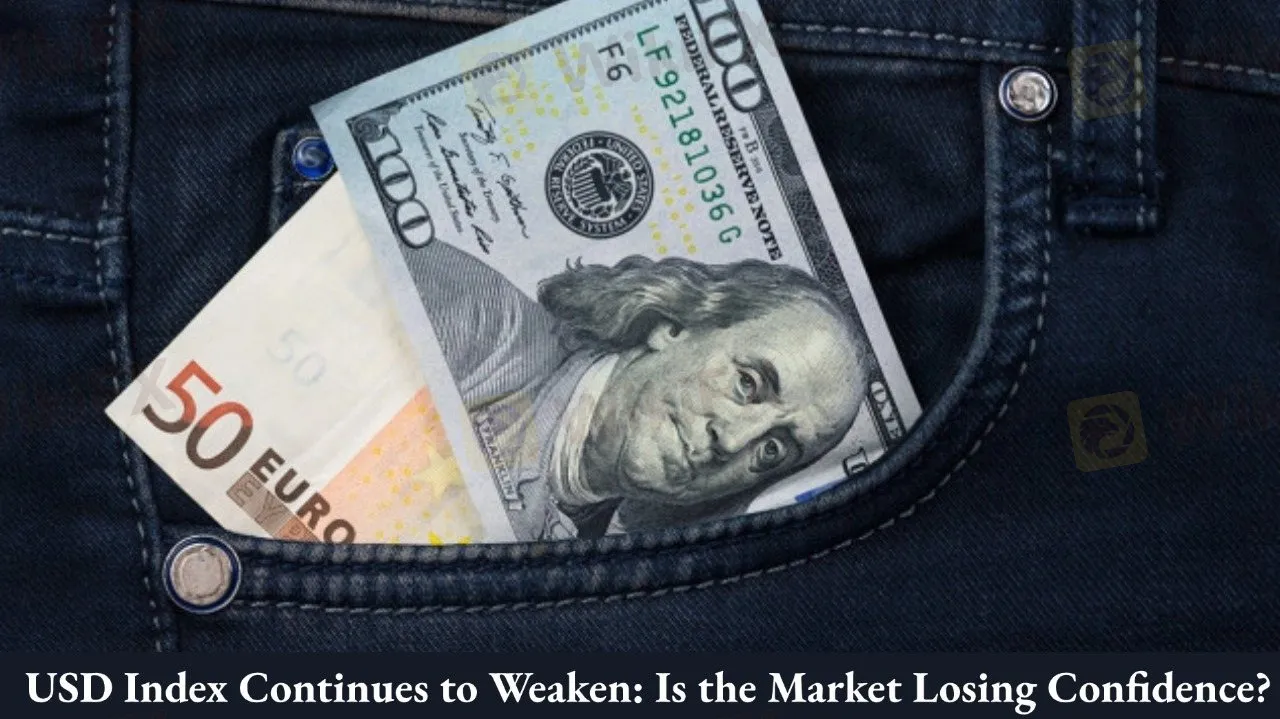简体中文
繁體中文
English
Pусский
日本語
ภาษาไทย
Tiếng Việt
Bahasa Indonesia
Español
हिन्दी
Filippiiniläinen
Français
Deutsch
Português
Türkçe
한국어
العربية
USD Index Continues to Weaken: Is the Market Losing Confidence?
Abstract:Recently, the USD index has continued to weaken, with a noticeable shift in market sentiment. Investor optimism is fading as key policy decisions and trade negotiations loom, creating uncertainty about future trends.

On May 6, the USD index continued its downward trajectory, with market optimism about trade agreements fading and increased volatility in emerging Asian currencies putting further pressure on the USD. As the Federal Reserve and Bank of Englands policy meetings approach, investor sentiment has become more cautious, and technical indicators show that the market is in a consolidation phase. According to the 60-minute chart, the USD index is hovering around the middle Bollinger Band (99.81), signaling a short-term balance with a slightly bearish bias. The technical indicators show that the market is caught in a tug-of-war between bulls and bears, and no clear trend has emerged.
On the 240-minute chart, the USD index shows a wider range within the Bollinger Bands (upper band at 100.27, middle band at 99.89, and lower band at 99.51). The current price of 99.78 is above the middle band, indicating a weak bullish inclination in the medium term, but momentum is insufficient for a strong upward movement. Overall, the USD index is in a consolidation phase, and market sentiment has not provided any clear direction.
Reasons Behind the Weakening USD Index
The weakness in the USD index can primarily be attributed to two factors. First, market expectations for a trade agreement between the US and China have turned more pessimistic. Previously, there was optimism about tariff reductions, but now, with negotiations stalling, the market is becoming increasingly cautious. As one prominent forex strategist stated, “The previous optimism about a trade agreement has faded, and investors are starting to focus on the potential impact of tariffs on the global economy.” This shift in sentiment has led to a reduction in demand for the USD, with funds flowing into safe-haven assets or other currencies.
Secondly, the Federal Reserve's policy stance is also influencing the USD. The market widely expects that the Federal Reserve will keep interest rates unchanged in its upcoming meeting. However, investors are closely watching the Fed's language regarding the economic outlook and its stance on future rate hikes. Meanwhile, the Bank of England faces growing pressure to address the slowing economy, and a rate cut could be on the horizon. This central bank policy battle is adding further uncertainty to the USD's outlook.
In the near term, the USD index is likely to continue fluctuating within a narrow range. The 60-minute chart shows tight trading intervals, while the 240-minute chart indicates a wider range, signaling that the market is waiting for policy decisions and trade news to guide the next move. If the Federal Reserve adopts a more hawkish stance or there is a breakthrough in trade negotiations, the USD could experience a short-term rebound. On the other hand, if risk sentiment rises and capital continues to flee the USD, further weakness could ensue.
In the medium term (1-2 weeks), both technical and fundamental factors lack clear direction. However, the risk of further downside is gradually building. If the trend of capital inflows into emerging markets continues, combined with major central banks' easing policies, the USD index could test key support levels around 99.00. Investors will need to closely monitor forward guidance from policy statements and developments in Asian currency markets, as unexpected news could trigger a sharp reversal.
Challenges Investors Will Face in the Future
For investors, the ongoing weakness in the USD index presents a more uncertain investment environment. A weak USD may push capital toward emerging market currencies or other safe-haven assets, particularly in the context of trade uncertainty and policy changes. Investors must balance technical and fundamental factors and remain alert to Federal Reserve and other central bank policy statements to adjust their strategies accordingly.
In the short term, the USD index is likely to remain in a consolidation phase. The 60-minute chart shows a narrow range, while the 240-minute chart indicates a broader range, suggesting the market is waiting for external catalysts, such as policy meetings and trade updates. If the Federal Reserve adopts a more hawkish tone or there is progress in trade negotiations, the USD may experience a short-term rebound. Conversely, increasing risk aversion may lead to further capital outflows from the USD.
In the medium term, there is no clear direction from either technical or fundamental indicators, but the risks are skewed to the downside. If capital continues to flow into emerging markets, coupled with easing policies from major central banks, the USD could face further pressure. Investors should pay close attention to policy statements and any sudden changes in market sentiment, as unexpected news could quickly alter the trend.
The continued weakness in the USD index reflects the market's growing uncertainty about the future economic outlook and trade developments. Although the USD may continue to consolidate in the short term, the risk of further downside is increasing. Investors need to be vigilant about policy changes and global economic conditions, as these could drive market trends. In this uncertain environment, diversification and flexible investment strategies are key to navigating the challenges ahead. As volatility increases, traders should prioritize risk management and wait for clearer signals before committing to major positions.

Disclaimer:
The views in this article only represent the author's personal views, and do not constitute investment advice on this platform. This platform does not guarantee the accuracy, completeness and timeliness of the information in the article, and will not be liable for any loss caused by the use of or reliance on the information in the article.
Read more

WikiFX Elite Club Committee Makes Its Debut, Charting the Future of the Global Trading Ecosystem
November 11, 2025 – The WikiFX Elite Club Committee (hereafter “the Elite Committee”) made its significant debut on the international stage at WikiEXPO Dubai 2025. Core members from the Middle East, Southeast Asia, and Chinese-speaking regions gathered to witness the beginning of a new chapter for the Elite Club.

WikiEXPO Dubai 2025 Concludes Successfully — Shaping a Transparent, Innovative Future
On November 11, WikiEXPO Dubai 2025, hosted by WikiGlobal and co-organized by WikiFX, successfully concluded. As one of the world’s most influential Fintech expos, this event brought together more than 570 regulatory representatives, industry leaders, and innovation pioneers from across the globe. Through in-depth discussions on core issues such as regulatory compliance, the forex market, investment strategies, and sustainable finance, the event delivered a profound experience that masterfully blended intellectual depth with actionable insights.

Russian crypto millionaire couple found dismembered and buried in Dubai desert
A gruesome case has emerged involving a Russian couple living in the United Arab Emirates who went missing in early October and whose remains were recently discovered in a desert near Dubai. Roman Novak, a self-styled cryptocurrency “millionaire”, and his wife Anna had last been seen travelling to a supposed investor meeting in the UAE, but according to investigators were instead abducted and murdered after a ransom plot failed.

Webull Introduces AI-Powered Decision Partner “Vega” to Elevate Investor Intelligence
An online investment platform named Webull, has unveiled Vega, the next evolution of its AI-powered decision partner, designed to deliver deeper, personalized insights that help investors navigate the ever-changing financial markets with confidence.
WikiFX Broker
Latest News
Is Fyntura a Regulated Broker? A Complete 2025 Broker Review
Zetradex Exposed: Withdrawal Denials, Account Freeze & Bonus Issues Hurt Traders
Is Forex Zone Trading Regulated and Licensed?
PINAKINE Broker India Review 2025: A Complete Guide to Safety and Services
Exness Restricted Countries List 2025 Explained
Is Uniglobe Markets Legit? A 2025 Simple Guide to Its Safety, Services, and User Warnings
Is Inzo Broker Safe or a Scam? An Evidence-Based Analysis for Traders
WikiEXPO Dubai 2025 “Welcome Party” Kicks Off Tonight!
He Trusted a WhatsApp Group and Lost RM659,000
Moomoo Singapore Opens Investor Boutiques to Strengthen Community
Currency Calculator



